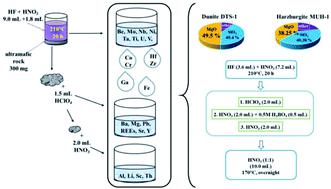当前位置:
X-MOL 学术
›
J. Anal. At. Spectrom.
›
论文详情
Our official English website, www.x-mol.net, welcomes your feedback! (Note: you will need to create a separate account there.)
An investigation of trace elements' behavior during chemical preparation of ultramafic matrix rock samples using bomb digestion for analysis by ICP-MS
Journal of Analytical Atomic Spectrometry ( IF 3.4 ) Pub Date : 2020-08-27 , DOI: 10.1039/d0ja00255k Okina Olga Ilyinichna 1, 2, 3 , Lyapunov Sergey Michailovich 1, 2, 3 , Dubenskiy Alexander Sergeevich 1, 2, 3 , Erofeeva Kseniya Gennadievna 1, 2, 3
Journal of Analytical Atomic Spectrometry ( IF 3.4 ) Pub Date : 2020-08-27 , DOI: 10.1039/d0ja00255k Okina Olga Ilyinichna 1, 2, 3 , Lyapunov Sergey Michailovich 1, 2, 3 , Dubenskiy Alexander Sergeevich 1, 2, 3 , Erofeeva Kseniya Gennadievna 1, 2, 3
Affiliation

|
Dissolution of trace and matrix elements during chemical treatment was studied using an ultramafic reference sample of dunite, DTS-1. Two kinds of spikes were used to enhance the extremely low concentrations in the analyzed fractions and to cross check effects, which could come from differences in the matrix and species of the added elements. They were an aliquot of the standard solution in nitric acid and a test portion of the control ultramafic alkali rock sample of the nephelinite NKT-1. A total test portion of 300 mg was chosen for the investigation taking into account the possible heterogeneity of the ultramafic rock samples. More than 77% of Be, Mo, Nb, Ni, Ta, Ti, U and V; 65–85% of Zr and Hf; 32–52% of Co, Cr and Ga; 20–32% of Fe; 10–20% of Al, Pb, Sc, and Sr and about 5% of Ba were dissolved during the bomb digestion stage. Rare earth elements (REEs), Y, Th, Li and Mg were found in the precipitate. The first treatment with perchloric acid resulted in dissolution of a majority of the precipitate. But more than 80% of Al, Th and about 70% of Li and Sc were caught with the residue that still remained after the first treatment. Seven schemes of the chemical preparation were studied using the dunite DTS-1 and the harzburgite MUH-1. The bomb digestion of a 300 mg test portion of the samples using a mixture of HF : HNO3 in ratios of 5 : 1, 1 : 1 and 1 : 2 resulted in complete decomposition of spinel, which is the most resistant ultramafic rock mineral to be dissolved. The main problem discovered was to dissolve elements which were caught with the residue that formed at the bomb digestion stage and contained predominantly MgF2. For accurate simultaneous determination of Ba, Be, Co, Cr, Cs, Ga, Hf, Li, Mo, Nb, Ni, Pb, Rb, Sc, Sr, Ta, Th, U, V, Zr, REEs and Y in ultramafic rocks with various MgO contents, it is necessary to use the mixture of HF : HNO3 with a ratio of 1 : 2 at the bomb digestion stage and perchloric, boric and nitric acids in subsequent evaporation steps.
中文翻译:

ICP-MS分析炸弹消解化学法制备超镁铁基质岩石样品中微量元素的行为
使用Dunite DTS-1超镁铁质参考样品研究了化学处理过程中微量元素和基质元素的溶解情况。两种加标被用来提高所分析馏分中的极低浓度并交叉检验效果,这可能是由于基质和所添加元素的种类不同而引起的。它们是硝酸中标准溶液的等分试样,是霞石NKT-1的对照超镁铁质碱性岩石样品的测试部分。考虑到超镁铁质岩石样品可能的异质性,选择总测试量为300 mg进行研究。铍,钼,铌,镍,钽,钛,铀和钒的77%以上; Zr和Hf的65-85%;钴,铬和镓的32–52%;铁的20–32%;在炸弹消化阶段,溶解了10–20%的Al,Pb,Sc和Sr,以及大约5%的Ba。在沉淀物中发现了稀土元素(REE),Y,Th,Li和Mg。高氯酸的第一次处理导致大部分沉淀物溶解。但是捕获的Al,Th以及大约70%的Li和Sc中的80%以上被残留在第一次处理后仍残留的残留物捕获。使用了Dunite DTS-1和harzburgite MUH-1研究了七个化学制备方案。使用HF:HNO的混合物对300 mg测试样品的炸弹消解 使用了Dunite DTS-1和harzburgite MUH-1研究了七个化学制备方案。使用HF:HNO的混合物对300 mg测试样品的炸弹消解 使用了Dunite DTS-1和harzburgite MUH-1研究了七个化学制备方案。使用HF:HNO的混合物对300 mg测试样品的炸弹消解3 5在比:1,1:1和1:2导致尖晶石的完全分解,这是最耐超镁铁质岩石矿物中溶解。发现的主要问题是溶解被炸弹消化阶段形成的残留物所捕获并主要含有MgF 2的元素。为了同时准确测定超镁铁矿中的Ba,Be,Co,Cr,Cs,Ga,Hf,Li,Mo,Nb,Ni,Pb,Rb,Sc,Sr,Ta,Th,U,V,Zr,REEs和Y对于MgO含量不同的岩石,在炸弹消化阶段必须使用HF:HNO 3的比例为1:2的混合物,并在随后的蒸发步骤中使用高氯酸,硼酸和硝酸的混合物。
更新日期:2020-11-03
中文翻译:

ICP-MS分析炸弹消解化学法制备超镁铁基质岩石样品中微量元素的行为
使用Dunite DTS-1超镁铁质参考样品研究了化学处理过程中微量元素和基质元素的溶解情况。两种加标被用来提高所分析馏分中的极低浓度并交叉检验效果,这可能是由于基质和所添加元素的种类不同而引起的。它们是硝酸中标准溶液的等分试样,是霞石NKT-1的对照超镁铁质碱性岩石样品的测试部分。考虑到超镁铁质岩石样品可能的异质性,选择总测试量为300 mg进行研究。铍,钼,铌,镍,钽,钛,铀和钒的77%以上; Zr和Hf的65-85%;钴,铬和镓的32–52%;铁的20–32%;在炸弹消化阶段,溶解了10–20%的Al,Pb,Sc和Sr,以及大约5%的Ba。在沉淀物中发现了稀土元素(REE),Y,Th,Li和Mg。高氯酸的第一次处理导致大部分沉淀物溶解。但是捕获的Al,Th以及大约70%的Li和Sc中的80%以上被残留在第一次处理后仍残留的残留物捕获。使用了Dunite DTS-1和harzburgite MUH-1研究了七个化学制备方案。使用HF:HNO的混合物对300 mg测试样品的炸弹消解 使用了Dunite DTS-1和harzburgite MUH-1研究了七个化学制备方案。使用HF:HNO的混合物对300 mg测试样品的炸弹消解 使用了Dunite DTS-1和harzburgite MUH-1研究了七个化学制备方案。使用HF:HNO的混合物对300 mg测试样品的炸弹消解3 5在比:1,1:1和1:2导致尖晶石的完全分解,这是最耐超镁铁质岩石矿物中溶解。发现的主要问题是溶解被炸弹消化阶段形成的残留物所捕获并主要含有MgF 2的元素。为了同时准确测定超镁铁矿中的Ba,Be,Co,Cr,Cs,Ga,Hf,Li,Mo,Nb,Ni,Pb,Rb,Sc,Sr,Ta,Th,U,V,Zr,REEs和Y对于MgO含量不同的岩石,在炸弹消化阶段必须使用HF:HNO 3的比例为1:2的混合物,并在随后的蒸发步骤中使用高氯酸,硼酸和硝酸的混合物。



























 京公网安备 11010802027423号
京公网安备 11010802027423号